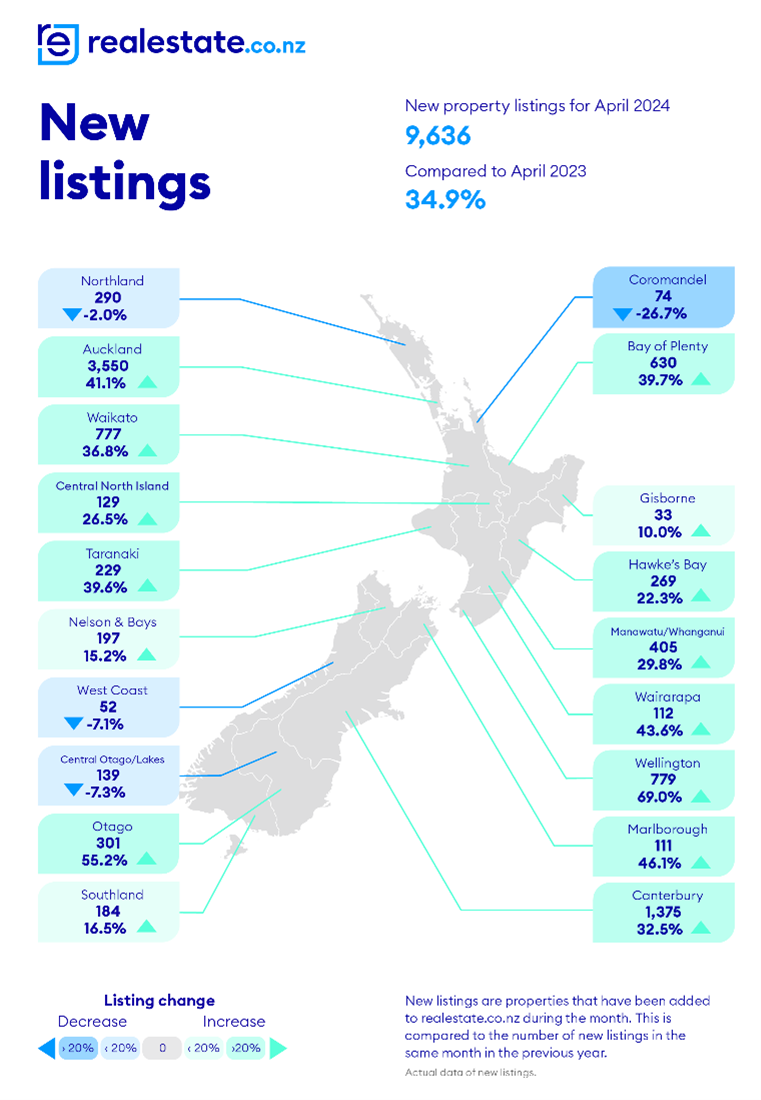- National average asking price virtually unchanged for over a year
- Central Otago/Lakes District and West Coast defy national trends
- Southland takes the title of the most cost-effective region
Increasing costs of living, high interest rates, and recessionary pressures all impacted the New Zealand property market in April. New data from realestate.co.nz indicates a nationwide downturn in property demand1, a trend that extends across most regions.
Demand in this context is measured by searches and engagements per listing, which are reliable gauges of buyer interest relative to available properties. Nationally, searches per listing were down 10.4%, and engagements per listing decreased by 7.5% year-on-year. On a regional level, searches per listing were down or static in 13 of our 19 regions, and engagements per listing decreased in 11.
Sarah Wood, CEO of realestate.co.nz, notes:
“This indicates a cooling of buyer interest amid economic uncertainty. It is a significant shift as most regions have experienced year-on-year demand growth during 2024 until now.”
She notes that economic reports show that consumer confidence was down during April and that declining demand for property also reflects this:
“In response to the recession, buyers are understandably cautious,” adds Wood.
Roughly 59% of New Zealand’s existing mortgages (by value) are up for renewal within the next 12 months. “Those who fixed two years ago might soon move from interest rates of around 3.0% to around 7.0%. This is likely pulling liquidity from the market and dampening demand,” says Wood.
Contributing to this waning demand, stock levels were notably high last month – echoing figures from 2015. Up 18.1% on April 2023, there were 33,815 total homes available for sale.
New listings were also up nationally by 34.9% year-on-year. However, as this follows an unusually low period in April 2023 due to weather events, these new listing levels are a return to normalcy rather than an indication of a boom. 

1Demand measures the level of serious buyer interest compared to the available supply by tracking two key metrics: searches per listing and engagements per listing. ‘Searches per listing’ divides the total number of searches on realestate.co.nz by the available stock, while ‘engagements per listing’ calculates the total number of enquiries and property saves divided by the available stock, providing a clearer picture of active interest in the market.
National average asking price virtually unchanged for over a year
Since January 2023, the national average asking price has remained stable. At $868,877, it is down a marginal 0.6% on April last year and down 1.8% month-on-month
Wood notes that the national average asking price has remained below $900,000 since December 2022, a significant decrease from the market peak in January 2022 when it exceeded $1 million.
Overall, average asking prices were relatively stable during April, with 12 of 19 regions recording a year-on-year change of less than 5.0% up or down.
“As we move into the winter months, we typically see a cooling market, and in 2024, this is combined with a softening economy. It will be interesting to see how these factors play out for the property market in the coming months,” says Wood.
Bucking the trend in average asking prices was Central Otago/Lakes District and West Coast, which saw year-on-year increases  of 17.0% and 21.6%, respectively, albeit at different ends of the price spectrum. Properties in Taranaki also saw a lift in asking price, up 7.2% compared to last year.
of 17.0% and 21.6%, respectively, albeit at different ends of the price spectrum. Properties in Taranaki also saw a lift in asking price, up 7.2% compared to last year.
Central Otago/Lakes District and West Coast defy national trends
Your property market experience, of course, depends on where you are in the country. Wood explains that we often see significant variation between regions depending on their regional ‘micro-climate’ and where they are in the property market cycle.
This was particularly true for Central Otago/Lakes District and West Coast, where markets remained buoyant during April. Both regions bucked the national trend with year-on-year growth to average asking prices and decreases in new listings.
“While Central Otago/Lakes District boasts the highest average asking prices in the country, the West Coast remains one of the most cost-effective regions in New Zealand, with more than a $1.1 million difference in average asking prices between these two regions.”
“This stark contrast highlights the importance of seeking expert advice from your local agent when buying or selling, as no two regions are the same,” explains Wood.
Central Otago/Lakes District saw new listings drop by 7.3% compared to April 2023. The region also reported a month-on-month increase in demand, with searches per listing up 9.4% and engagements per listing up 3.5%. International views on listings in the region also increased by 18.6% year-on-year in Central Otago/Lakes District, suggesting that this remains a desirable spot for property seekers further afield. 31% of international views for this region are from property seekers based in Australia. Sitting just shy of $1.6 million, Central Otago/Lakes District also saw average asking prices increase by 17.0% year-on-year and 5.4% month-on-month.
West Coast, a small market, saw just 52 new listings hit the market in April; down 7.1% compared to 2023. At the same time, searches per listing (an indicator of demand) climbed 6.8% compared to 2023. The average asking price in the region also rose to $538,752 during April. This is the first time since June 2018 that average asking prices on the West Coast have been higher than Southland’s. Southland now has the lowest average asking price in New Zealand of $534,493. of $534,493.
Despite the current economic squeeze, buyers and sellers can still find valuable opportunities. Central Otago/Lakes District and West Coast show that there is not only something for every price point but that it’s not all doom and gloom for sellers during an economic downturn.
In these challenging times, buyers and sellers must stay informed and proactive. Leveraging expert advice can unlock potential opportunities,” emphasises Wood.
ENDS
For media enquiries, please contact:
Angela March | angela@brainchild.co.nz| Brainchild
About realestate.co.nz
We’ve been helping people buy, sell, or rent property since 1996.
Established before Google, realestate.co.nz is New Zealand’s longest-standing property website and the official website of the real estate industry.
Dedicated only to property, our mission is to empower people with a property search tool they can use to find the life they want to live. With residential, lifestyle, rural and commercial property listings, realestate.co.nz is the place to start for those looking to buy or sell property.
Whatever life you’re searching for, it all starts here.
Want more property insights?
- Market insights: Search by suburb to see median sale prices, popular property types and trends over time.
- Sold properties: Switch your search to sold to see the last 12 months of sales and prices.
- Valuations: Get a gauge on property prices by browsing sold residential properties, with the latest sale prices and an estimated value in the current market.
Glossary of terms:
Average asking price (AAP) is neither a valuation nor the sale price. It is an indication of current market sentiment. Statistically, asking prices tend to correlate closely with the sales prices recorded in future months when those properties are sold. As it looks at different data, average asking prices may differ from recorded sales data released simultaneously.
New listings are a record of all the new residential dwellings listed for sale on realestate.co.nz for the relevant calendar month. The site reflects 97% of all properties listed through licensed real estate agents and major developers in New Zealand. This description gives a representative view of the New Zealand property market.
Stock is the total number of residential dwellings that are for sale on realestate.co.nz on the penultimate day of the month.
Inventory is a measure of how long it would take, theoretically, to sell the current stock at current average rates of sale if no new properties were to be listed for sale. It provides a measure of the rate of turnover in the market.
Demand measures the level of serious buyer interest compared to the available supply. It does this by tracking two related datasets – searches and engagements per listing. Searches per listing divides the total number of searches on realestate.co.nz by stock. Engagements per listing divides the total number of enquiries and property saves by stock.
Seasonal adjustment is a method realestate.co.nz uses to represent better the core underlying trend of the property market in New Zealand. This is done using methodology from the New Zealand Institute of Economic Research.
Truncated mean is the method realestate.co.nz uses to supply statistically relevant asking prices. The top and bottom 10% of listings in each area are removed before the average is calculated to prevent exceptional listings from providing false impressions.



